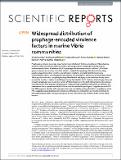Widespread distribution of prophage-encoded virulence factors in marine Vibrio communities
Author(s)
Castillo, Daniel; Hussain, Fatima; Kalatzis, Panos; Rørbo, Nanna; Middelboe, Mathias; Kauffman, Anne Kathryn Marie; Polz, Martin F; ... Show more Show less
Downloads41598-018-28326-9.pdf (2.782Mb)
PUBLISHER_CC
Publisher with Creative Commons License
Creative Commons Attribution
Terms of use
Metadata
Show full item recordAbstract
Prophages are known to encode important virulence factors in the human pathogen Vibrio cholerae. However, little is known about the occurrence and composition of prophage-encoded traits in environmental vibrios. A database of 5,674 prophage-like elements constructed from 1,874 Vibrio genome sequences, covering sixty-four species, revealed that prophage-like elements encoding possible properties such as virulence and antibiotic resistance are widely distributed among environmental vibrios, including strains classified as non-pathogenic. Moreover, we found that 45% of Vibrio species harbored a complete prophage-like element belonging to the Inoviridae family, which encode the zonula occludens toxin (Zot) previously described in the V. cholerae. Interestingly, these zot-encoding prophages were found in a variety of Vibrio strains covering both clinical and marine isolates, including strains from deep sea hydrothermal vents and deep subseafloor sediments. In addition, the observation that a spacer from the CRISPR locus in the marine fish pathogen V. anguillarum strain PF7 had 95% sequence identity with a zot gene from the Inoviridae prophage found in V. anguillarum strain PF4, suggests acquired resistance to inoviruses in this species. Altogether, our results contribute to the understanding of the role of prophages as drivers of evolution and virulence in the marine Vibrio bacteria.
Date issued
2018-07Department
Massachusetts Institute of Technology. Department of Civil and Environmental EngineeringJournal
Scientific Reports
Publisher
Nature Publishing Group
Citation
Castillo, Daniel et al. “Widespread Distribution of Prophage-Encoded Virulence Factors in Marine Vibrio Communities.” Scientific Reports 8, 1 (July 2018) © 2018 The Author(s)
Version: Final published version
ISSN
2045-2322